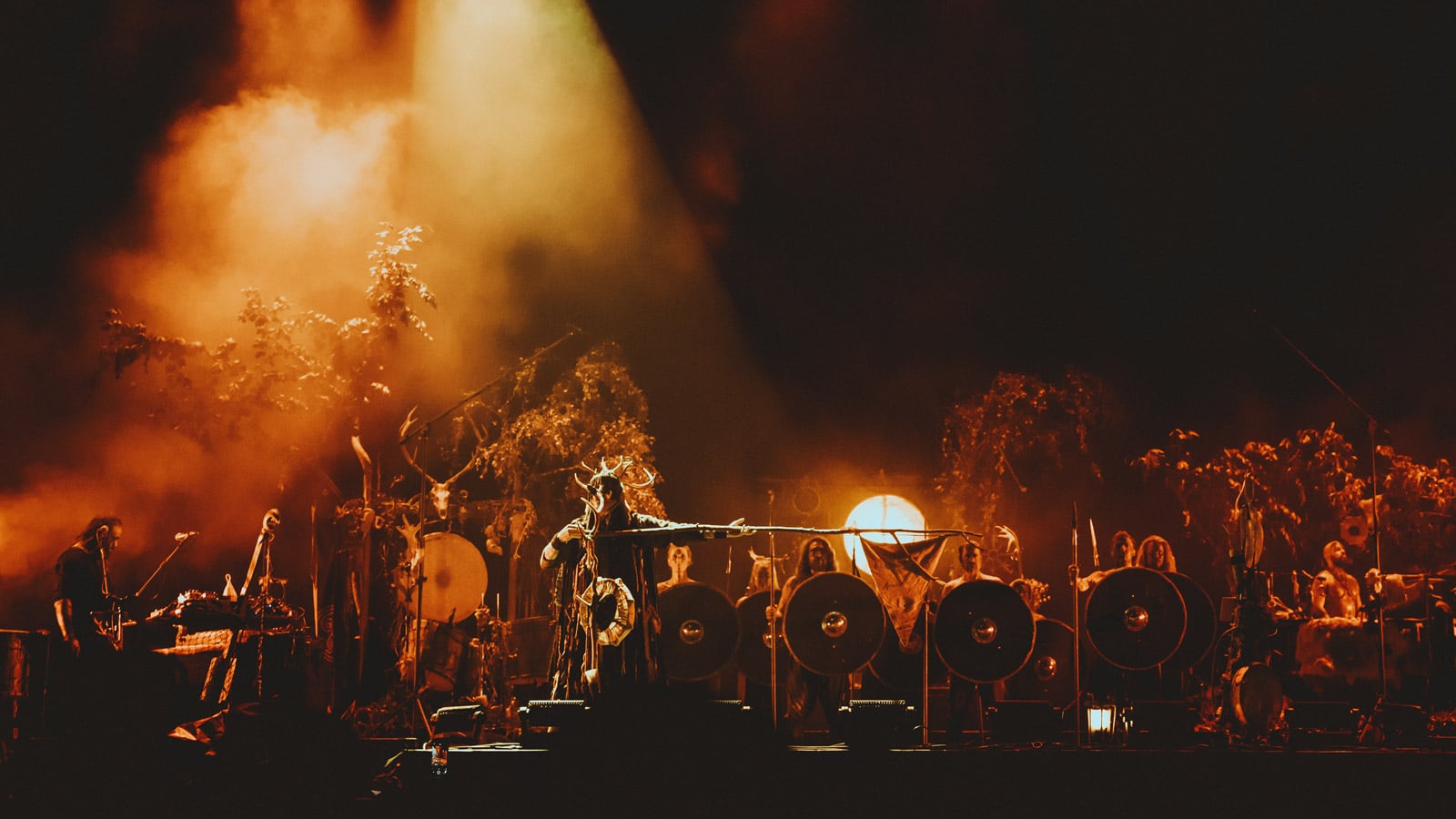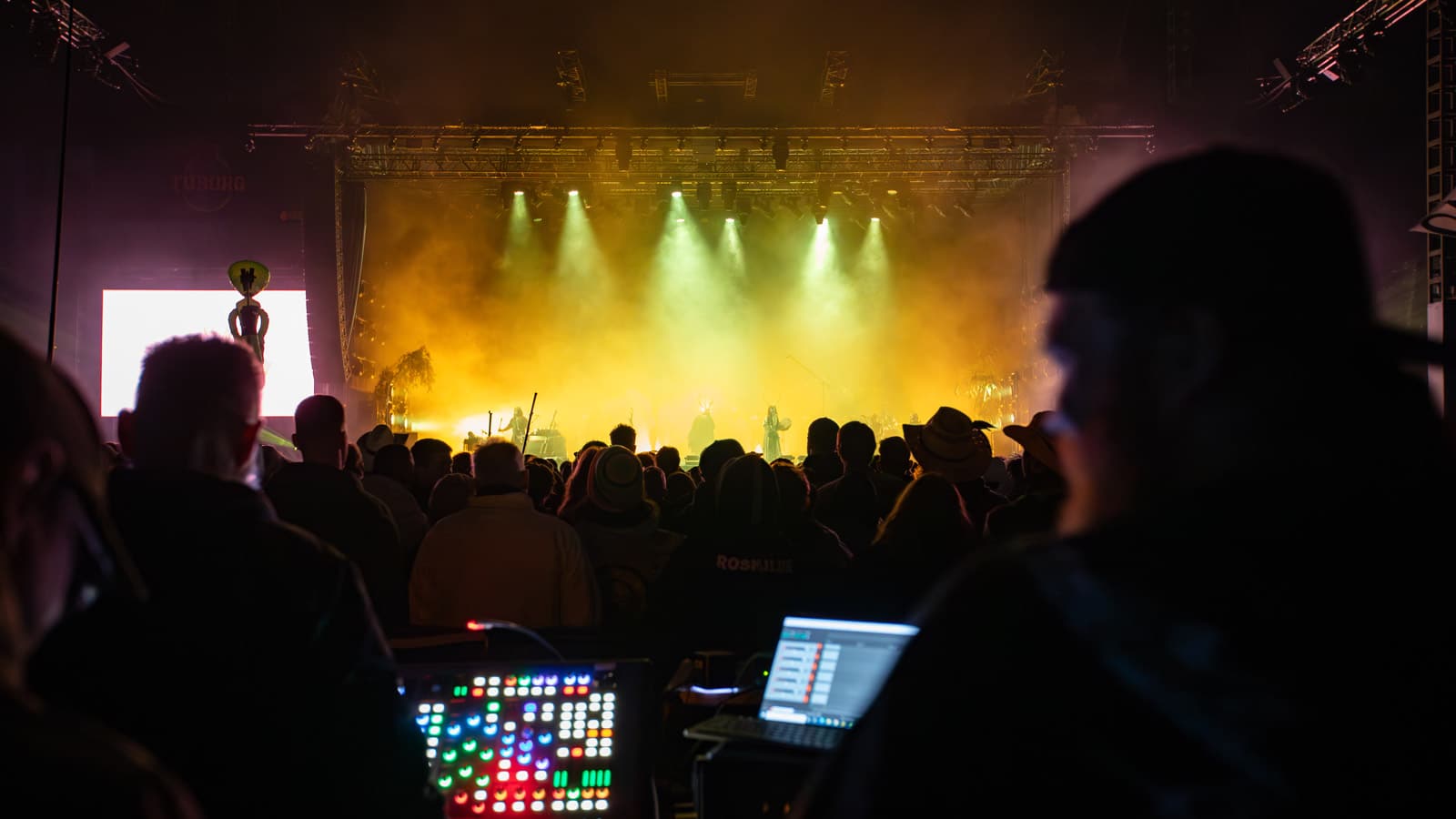Together with the acoustics of the tent, that creates the feeling of being in a cathedral or something more like that than a tent. I think the Galileo [GALAXY processor] is the heart of everything we are doing here, because it’s possible to create that good matrix, and we can still change it from time to time.”
Finn JansenFOH Engineer, Heilung
Roskilde Festival, Europe’s largest and longest-running music festival, is known for pushing creative boundaries and giving artists palettes to explore new sonic possibilities, made possible through collaboration with its exclusive sound provider, Meyer Sound.
In 2024, Roskilde’s sonic experiments reached new heights with an immersive performance by Nordic experimental folk collective Heilung, powered by Meyer Sound’s Spacemap Go spatial sound design and mixing tool.
Essentially a theater production on a rock stage, Heilung draws from ancestral cultures dating back to the Iron Age. Performances evoke ancient pagan rituals, combining throat singing, field recordings, and instruments crafted from stones, animal skins, and bones to create the otherworldly music the group describes as “Amplified History”.
“Heilung is an immersive experience in terms of a sort of shamanistic ritual that already immerses the audience in a spiritual way,” says bandleader Christopher Juul. “What we wanted to do here was to bring that into the audiovisual part of the performance. We also tried to figure out, what can we do with this technology. What are the physical limitations, and how do we bend them? And we got to some quite interesting things.”
For two months, Heilung worked closely with Meyer Sound Technical Support Specialist Arve Gotfredsen in Denmark, learning Spacemap Go, preparing sounds in the studio, and gradually scaling up production. “When we started out, Arve came and put up a much smaller system in our recording room, where we started to work out all of the ideas,” says the band’s longtime FOH engineer, Finn Jansen. On this 1:10 scale system, it was possible to simulate the full-scale system and experience the physical limitations of the large Arena tent. “We moved from there to a small venue with a capacity of 400 people, and we scaled up the speaker system. That’s where we were really convinced that this was going to be great. And then we got to the Arena stage, with 17,000 people.”
Roskilde’s Arena tent is a cavernous structure measuring 70 meters wide and 50 meters deep. Its Meyer Sound system centered around 46 PANTHER large-format linear array loudspeakers paired with 24 2100‑LFC low-frequency control elements, supported by 10 LEOPARD compact linear array loudspeakers; 36 LEOPARD loudspeakers and six 900‑LFC low-frequency control elements served as delays. For the Heilung performance the existing system was augmented using ground stacks consisting of a single 2100-LFC plus 4 PANTHER and additional flown ULTRA‑X40 loudspeakers. With the whole system controlled by Galileo GALAXY Network Platforms, connected via MILAN, every loudspeaker location was available in Spacemap Go.
From the outset, Heilung’s spatial approach was more about atmosphere than special effects. “On a creative level, I’ve been thinking a lot about it in the same way as when 3D imaging was coming into cinemas,” says Juul. “Do we want this 3D thing to go directly into our face and shock us? It can be fun once in a while as a gimmick, but for a whole movie, that can be a little bit too much. We rather want to go deep.”
This strategy also sidestepped latency issues inherent in synchronizing rhythmic sounds across vast distances. “The Arena stage is a big stage, which presents an obstacle in terms of sound travel over time,” Juul explains. “So we could not have, for instance, the drummer in one speaker and the singer in another. The solution we came up with was sounds that put you in specific locations. That could be nature sounds, or if it was a futuristic passage, that could be sci-fi sounds or city soundscapes, whatever.”
“We fed the X40s with a matrix from the desk with different reverbs and sound effects,” Jansen explains. “Together with the acoustics of the tent, that creates the feeling of being in a cathedral or something more like that than a tent. I think the Galileo [GALAXY processor] is the heart of everything we are doing here, because it’s possible to create that good matrix, and we can still change it from time to time.”
Heilung’s groundbreaking performance was one of many ways Meyer Sound pushed the boundaries of immersive sound at Roskilde, including research into spatial system design at the Gloria stage and a spatial tent at the Artist Village, which offered engineers, artists, and producers a chance to get hands-on with spatial sound tools, in collaboration with Denmark’s Sonic College.
“My hope for a successful Roskilde Festival as far as spatial goes would be to come back next year and see the seeds that we planted this year blossom into spatial experiences for the audiences and new creative experiences for those making the art,” says Meyer Sound Technical Support Specialist Leonard Blanche, who collaborated with engineers onsite.
For Heilung, the Roskilde immersive performance was just the beginning. “We are just at the baby steps of something completely new, and it’s very exciting to talk creatively about,” says Juul. “I’m very proud that we have been part of this experiment and there’s so much heart in it from all of the people behind it, from Meyer and the Roskilde Festival and Sonic College — all these people coming together to make the best performance possible.”








